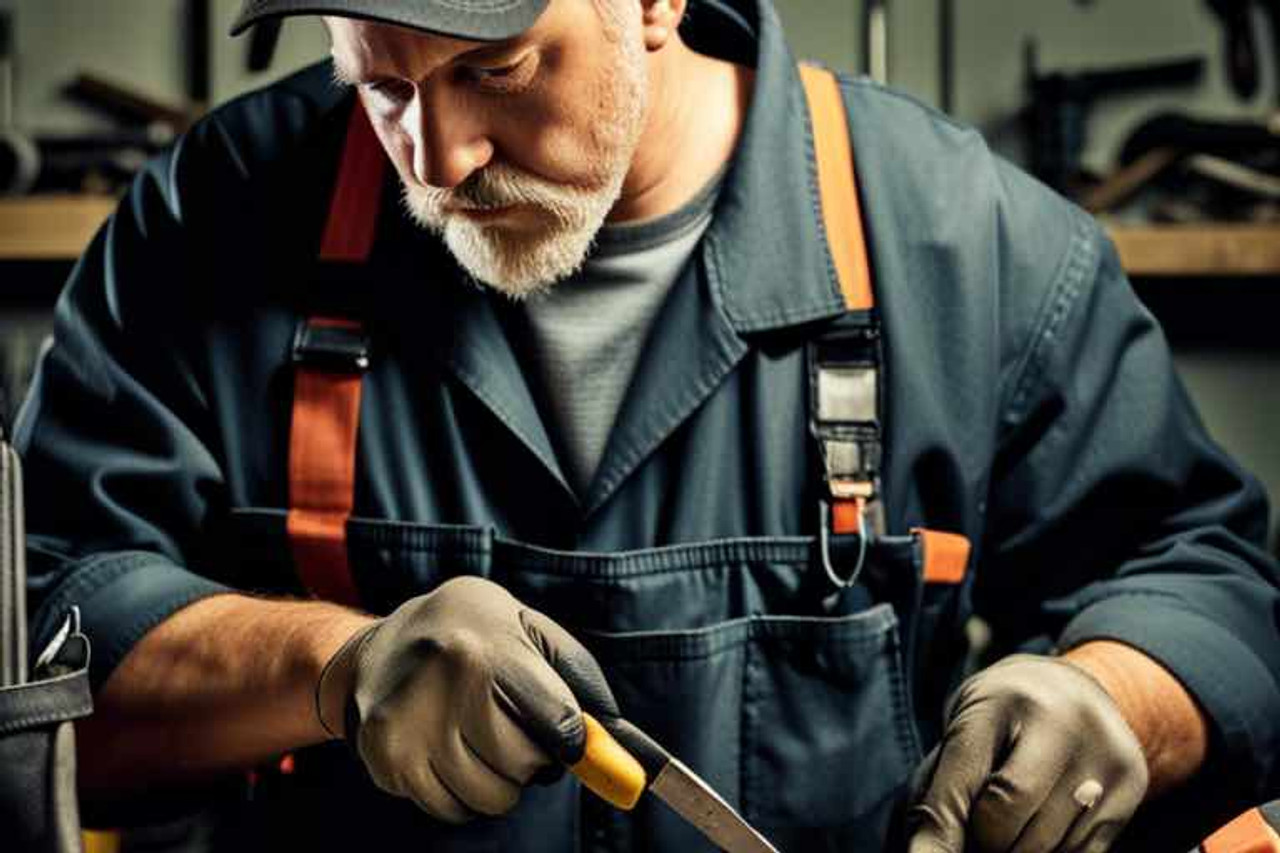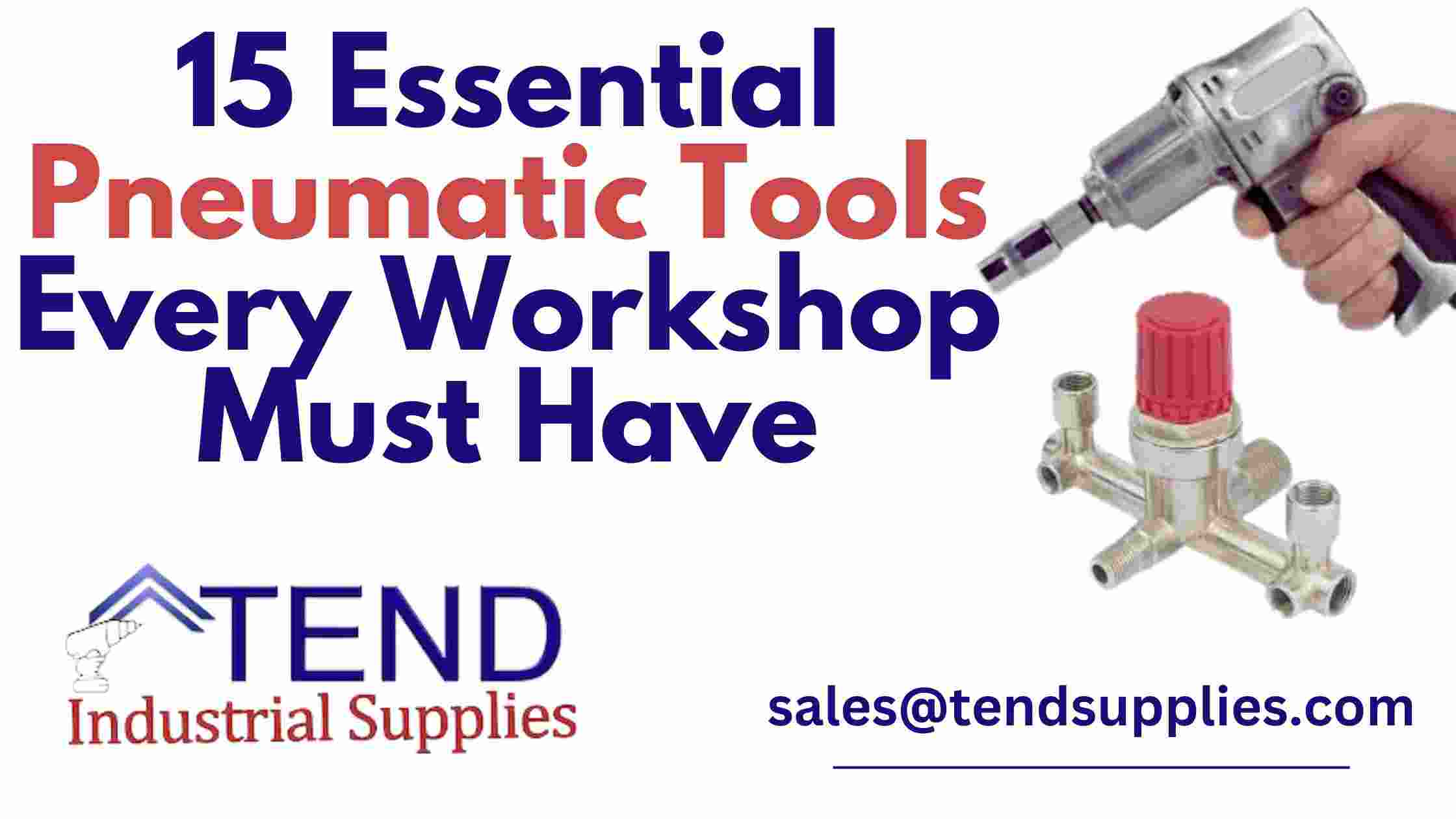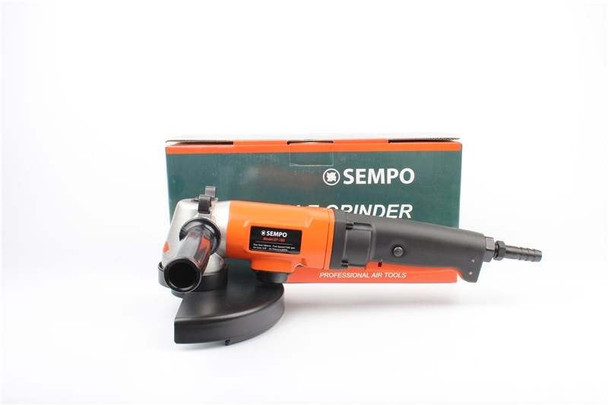15 Essential Pneumatic Tools Every Workshop Must Have
Pneumatic Tools Every Workshop Must Have
In workshops, having the right tools can make all the difference. Pneumatic tools, powered by compressed air, have revolutionized how we approach tasks, offering more power, efficiency, and versatility. These tools have become indispensable for professionals and hobbyists, from sanding to riveting. Dive into our comprehensive list of the 15 essential pneumatic tools that are transforming workshops around the globe.
Key Takeaway: Essential Pneumatic Tools for Workshops
Pneumatic tools are indispensable in modern workshops, offering unparalleled power, efficiency, and versatility:
- Versatility: From drilling to sanding, pneumatic tools cover a wide range of applications.
- Power-to-Weight Ratio: Air-powered tools deliver high performance with less user fatigue.
- Cost-Effectiveness: Generally more affordable and durable than electric counterparts.
- Precision: Many pneumatic tools offer superior control for detailed work.
- Safety: No risk of electric shock, making them safer in certain environments.
- Longevity: With proper maintenance, pneumatic tools often outlast electric alternatives.
Investing in a comprehensive set of pneumatic tools can significantly enhance workshop productivity and capabilities, making them essential for both professionals and serious DIY enthusiasts.
Pneumatic tools, or air-powered tools, utilize compressed air to operate. They are popular in various industries due to their power, efficiency, and durability. Here are some of the most common types of pneumatic tools:
Air Drills: Used for drilling holes in various materials, they are often more powerful than electric drills.
Air Impact Wrenches: Commonly used in automotive repair to remove and tighten lug nuts on wheels.
Air Hammers or Jackhammers: Used in construction to break up hard surfaces like concrete.
Air Ratchets: Similar to impact wrenches but used for jobs requiring less torque.
Air Grinders: Used for grinding, sanding, and polishing surfaces.
Air Sanders: Used for smoothing surfaces, especially in auto body repair.
Air Nailers and Staplers: Used for fastening materials together, they come in various types depending on the size and type of nail or staple.
Air Spray Guns: Used for painting and coating surfaces evenly.
Air Blow Guns: Used for cleaning surfaces and blowing away debris.
Air Chisels: Used for carving or cutting hard materials.
Air Compressors: While not a tool in the direct sense, compressors are essential for generating the compressed air that powers pneumatic tools.
Air Riveters: Used to install rivets, which are permanent mechanical fasteners.
Air Saws: Used for cutting through various materials, including metal and wood.
Air Grease Guns: Used for lubricating machinery and parts.
Air Caulking Guns:
Used to seal joints or seams in various structures and piping.
15 Important Pneumatic Tools Every workshop Should have
These are just a few examples, and the specific type of pneumatic tool one might encounter can vary based on the industry and application. However, all these tools offer the advantage of high power-to-weight ratios, making them efficient and often more effective than their electric or manual counterparts.
Air Drills:
Air drills are essential tools in various industries, especially where precision and power are required. They utilize compressed air to generate rotational force, making them more potent than many electric drills. Their efficiency is evident in tasks that require drilling through robust materials, where consistent power is crucial.
Example: The1/2 Shinano Reversible Pneumatic Drill 800 RPM SI-5305-8A from Tend Industrial Supplies is a testament to the power and versatility of air drills. It boasts a heavy-duty reversible function and low-speed high torque ideal for steel drilling and automotive work. The 13mm keyed chuck ensures a firm grip on drill bits, enhancing precision during operations.
Air Impact Wrenches:
These are powerful tools predominantly used in automotive repair. Thanks to the compressed air, they provide high torque output with minimal exertion by the user. This makes tasks like removing lug nuts or rusted bolts a breeze.
Example: TheShinano 3/8 Square Drive Pneumatic Air Impact Wrench available at Tend Industrial Supplies is a prime example of a high-quality air impact wrench. It's designed for efficiency, durability, and ease of use.
Air Hammers or Jackhammers:
These powerful tools break up hard surfaces like concrete, asphalt, or rocks. They deliver rapid hammering action powered by compressed air, making them highly effective for construction and demolition tasks.
Example: ThePistol Air Hammer Universal Tool UT8645-1 from Tend Industrial Supplies showcases the robustness and efficiency of air hammers. It's designed for maximum impact and longevity.
Air Ratchets:
Like impact wrenches, air ratchets are used to tighten or loosen nuts and bolts. However, they are designed for tasks that require less torque, making them suitable for more delicate operations.
Example: The3/8 Flex-Head Air Ratchet Aircat 811, available at Tend Industrial Supplies, is a versatile tool, offering flexibility and precision in operations.
Air Grinders:
These tools are used for various tasks like grinding, sanding, and polishing surfaces. They come with different attachments and can be used on metal to wood.
Example: The SP-180 Heavy Duty Pneumatic 7-inch Air Angle Grinder at Tend Industrial Supplies is a testament to the versatility and power of air grinders. It's ideal for tasks in welding, woodworking, and automotive detailing.
Each of these pneumatic tools, available at Tend Industrial Supplies, showcases the efficiency, power, and versatility that air tools bring to various industries. Whether you're in construction, automotive repair, or manufacturing, these tools are designed to enhance productivity and ensure precision in every task.
Air Sanders:
Air sanders are essential for achieving smooth surface finishes. They operate using compressed air, providing consistent and efficient sanding action. Espec ially in auto body repair, they help remove paint, rust, and other surface imperfections, preparing the surface for painting or refinishing.
Example: The Shinano Mini Dual Action Sander SI-2107A from Tend Industrial Supplies perfectly represents the efficiency of air sanders. It's designed for precision, offering dual-action sanding that ensures an even smooth finish.
Air Nailers and Staplers:
These tools are designed to fasten materials together quickly and efficiently. Depending on the task, there are various types, each tailored to a specific size or type of nail or staple. They offer rapid, consistent fastening, making them indispensable in carpentry and construction.
Example:- Consider this air nailer from Tend Industrial Supplies, known for its precision and ability to handle various nail sizes, ensuring materials are securely fastened.
Air Spray Guns:
Air spray guns are pivotal in achieving even coats of paint on surfaces. They use compressed air to atomize and spray paint, ensuring a smooth and consistent finish, which is especially crucial in automotive and furniture industries.
Example: TheFPX Air Tools HVLP Gravity Feed Spray Gun Kit FPX-535K available at Tend Industrial Supplies is a testament to the precision and efficiency of air spray guns. It ensures a high-quality finish with minimal paint wastage.
Air Blow Guns:
These are tools designed for cleaning tasks. They use compressed air to remove debris, dust, and other contaminants from surfaces, ensuring a clean work environment. They're instrumental in workshops where precision and cleanliness are paramount.
Example - Consider this air blow gun from Tend Industrial Supplies, known for its powerful air output, ensuring surfaces are clean and debris-free.
Air Chisels:
Air chisels are designed for tasks that require carving or cutting hard materials. They offer a rapid chiseling action, making them invaluable in sculpting and construction tasks where precision is crucial.
Example: The Scribe Engraving Chisel Universal Tool UT8617 from Tend Industrial Supplies showcases the precision and power of air chisels. It's designed for detailed engraving tasks, ensuring accuracy and a fine finish.
These pneumatic tools, available at Tend Industrial Supplies, exemplify the power, efficiency, and precision that air tools bring to various tasks. Whether you're in construction, automotive repair, or arts and crafts, these tools ensure you achieve the best results in your projects.
Air Compressors: Air compressors are the heart of any pneumatic tool setup. While they might not be a direct tool, their role is indispensable. They generate the compressed air that powers all pneumatic tools, ensuring they operate optimally.
Air Riveters:
These are specialized tools designed to install rivets. Rivets are permanent mechanical fasteners, and with air riveters, the installation process becomes swift and efficient, ensuring a secure fit.
Air Saws:
Air saws are the go-to tools for tasks requiring cutting through materials. They offer precision and power, making it easier to cut through various materials, be it metal, wood, or plastic.
Example: TheReciprocating Air Saw Universal Tool UT9155 from Tend Industrial Supplies is a testament to the efficiency and power of air saws. It ensures smooth and precise cuts, making it a favorite among professionals.
Air Grease Guns:
Maintenance is crucial for any machinery or parts. Air grease guns make the lubrication process efficient, ensuring that machinery operates smoothly and has a longer lifespan.
Air Caulking Guns:
Air caulking guns are essential for tasks requiring sealing joints or seams. They ensure a tight seal, which is especially crucial in structures and piping, preventing leaks and ensuring durability.
In the world of pneumatic tools, each tool has its unique role, ensuring tasks are done efficiently and effectively. Whether you're a professional or a DIY enthusiast, investing in quality air tools is a decision you won't regret.
Safety Considerations: Pneumatic tools can be incredibly efficient, but prioritizing safety is crucial. Always wear appropriate safety gear, such as safety glasses, hearing protection, and gloves, when operating these tools. Ensure you use the correct fittings and attachments for each tool and maintain a safe working distance from the work surface.
Maintenance Tips: Regular maintenance extends the lifespan and optimizes the performance of your pneumatic tools. Simple practices include lubricating moving parts according to the manufacturer's instructions, draining condensation from the air tank regularly, and cleaning air filters to prevent clogging
Safety Considerations: Pneumatic tools can be incredibly efficient, but prioritizing safety is crucial. Always wear appropriate safety gear, such as safety glasses, hearing protection, and gloves, when operating these tools. Ensure you use the correct fittings and attachments for each tool and maintain a safe working distance from the work surface.
Maintenance Tips: Regular maintenance extends the lifespan and optimizes the performance of your pneumatic tools. Simple practices include lubricating moving parts according to the manufacturer's instructions, draining condensation from the air tank regularly, and cleaning air filters to prevent clogging.
Choosing the Right Pneumatic Tools for Your Workshop
Selecting the appropriate pneumatic tools for your workshop requires careful consideration of several factors:
- Assess Your Needs
- Identify the tasks you regularly perform
- Consider the materials you work with most often
- Determine the frequency and intensity of tool use
- Evaluate Your Air Compressor
- Check the CFM (Cubic Feet per Minute) output
- Verify the PSI (Pounds per Square Inch) range
- Ensure your compressor can handle your intended tools
- Consider Tool Specifications
- Look for tools that match your compressor's capabilities
- Check the tool's CFM requirements at 90 PSI
- Verify the tool's operating pressure range
- Quality and Durability
- Invest in reputable brands known for reliability
- Look for tools with robust construction (e.g., metal bodies over plastic)
- Check warranty offerings and customer support
- Ergonomics and Comfort
- Choose tools that feel comfortable during extended use
- Look for features like vibration reduction and ergonomic grips
- Consider the weight of the tool for overhead or extended use
- Versatility
- Opt for tools with adjustable settings when possible
- Look for tools compatible with various attachments or accessories
- Consider multi-purpose tools to maximize value
- Budget Considerations
- Balance cost with expected usage and durability
- Consider long-term value over initial price
- Look for package deals or kits for better value
- Noise Levels
- Check decibel ratings, especially for indoor use
- Consider quieter models if noise is a concern in your workspace
- Compatibility
- Ensure tools are compatible with your existing air fittings and hoses
- Check if the tool requires any special lubricants or accessories
- Future Expansion
- Consider your workshop's growth potential
- Choose tools that can adapt to increasing demands
By carefully considering these factors, you can select pneumatic tools that not only meet your current needs but also serve you well as your skills and workshop evolve.
Safety and Maintenance Tips for Pneumatic Tools
Proper use and maintenance of pneumatic tools are crucial for safety, longevity, and optimal performance.
Safety Tips
- Personal Protective Equipment (PPE)
- Always wear safety glasses or goggles
- Use hearing protection, especially with high-noise tools
- Wear work gloves to improve grip and protect hands
- Proper Training
- Familiarize yourself with each tool's operation manual
- Practice on scrap materials before tackling important projects
- Never use a tool for tasks it's not designed for
- Workspace Safety
- Ensure adequate lighting and ventilation
- Keep work area clean and free of tripping hazards
- Secure workpieces properly to prevent movement during use
- Air Supply Safety
- Inspect air hoses regularly for damage or wear
- Use hose whip checks to prevent hose disconnection accidents
- Never carry a tool by the hose or yank the hose to disconnect
- Tool-Specific Safety
- Use safety features like trigger locks when provided
- Never bypass or remove safety mechanisms
- Keep hands away from moving parts during operation
Maintenance Tips
- Regular Cleaning
- Clean tools after each use to prevent debris buildup
- Use appropriate solvents or cleaners recommended by the manufacturer
- Ensure tools are completely dry before storage
- Lubrication
- Lubricate tools daily or before each use with air tool oil
- Follow manufacturer's recommendations for lubrication points and frequency
- Never use standard motor oil as it can damage seals
- Air System Maintenance
- Drain moisture from the air compressor tank daily
- Clean or replace air filters regularly
- Check and tighten all fittings to prevent air leaks
- Inspection Routine
- Regularly inspect tools for signs of wear or damage
- Check for loose screws, bolts, or fittings
- Test tools briefly before each use to ensure proper function
- Proper Storage
- Store tools in a clean, dry place
- Use tool cases or wall mounts to prevent damage
- Disconnect tools from air supply when not in use
- Timely Repairs
- Address any issues promptly to prevent further damage
- Use only manufacturer-approved replacement parts
- Consider professional servicing for complex repairs
- Air Compressor Care
- Follow the compressor's maintenance schedule rigorously
- Check belt tension and alignment regularly (for belt-driven models)
- Keep the compressor clean and well-ventilated
- Documentation
- Keep a maintenance log for each tool
- Record dates of service, repairs, and part replacements
- Retain user manuals and warranty information
By following these safety and maintenance practices, you can ensure the longevity of your pneumatic tools, maintain a safe working environment, and achieve optimal performance in your workshop projects.
FAQs: Essential Pneumatic Tools for Workshops
- Q: What size air compressor do I need for most pneumatic tools? A: For most workshop applications, a compressor with 20-30 gallon tank capacity and 4-5 CFM at 90 PSI is sufficient. However, high-demand tools like sanders may require larger compressors. Always check the specific tool requirements.
- Q: Are pneumatic tools more powerful than their electric counterparts? A: Generally, yes. Pneumatic tools often deliver more power and torque for their size compared to electric tools. This makes them particularly effective for heavy-duty tasks like automotive work or construction.
- Q: How do I maintain my pneumatic tools to ensure longevity?
A: Regular maintenance is key:
- Lubricate tools with air tool oil before each use
- Clean tools after use and store in a dry place
- Drain moisture from the air compressor tank regularly
- Replace worn parts promptly
- Follow manufacturer's specific maintenance instructions
- Q: Can I use the same air hose for all my pneumatic tools? A: While many tools use standard fittings, it's important to check the air flow requirements (CFM) and pressure (PSI) for each tool. Some high-demand tools may require larger diameter hoses for optimal performance.
- Q: Are pneumatic tools safe to use in wet conditions? A: Pneumatic tools are generally safer than electric tools in damp environments as there's no risk of electric shock. However, always follow safety guidelines, avoid submerging tools in water, and ensure proper grounding of the air compressor.
Conclusion:
Pneumatic tools have revolutionized various industries, offering power, precision, and efficiency. They ensure tasks are completed faster, with greater accuracy, and often with less physical strain on the user. Consider the vast range of pneumatic tools available at Tend Industrial Supplies to elevate your toolkit or workshop.
Call to Action: Dive into a world of efficiency, power, and precision with Tend Industrial Supplies. Explore our extensive range of pneumatic tools and elevate your work to new heights. For inquiries, orders, and more, contact us at sales@tendsupplies.com or our website at tendsupplies.com. Your following best tool is just a click away!
Alternative Power Sources: While traditionally powered by compressed air, some pneumatic tools are now available in cordless electric versions. These cordless options offer portability and convenience for specific applications where maneuverability is essential. Consider your workspace and project needs when choosing between pneumatic and cordless tools.














